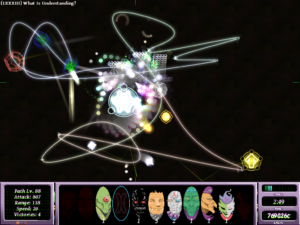Immortal Defense
 I’ve known since I tried the limited demo of Immortal Defense that I wanted give the full game a try at some point, and with the author putting it on a temporary “pay-what-you-want” sale, now seemed like the time. (The sale seems to have a few more hours left as I write this, although the phrase “until January 1st” is kind of ambiguous.)
I’ve known since I tried the limited demo of Immortal Defense that I wanted give the full game a try at some point, and with the author putting it on a temporary “pay-what-you-want” sale, now seemed like the time. (The sale seems to have a few more hours left as I write this, although the phrase “until January 1st” is kind of ambiguous.)
The premise is that hostile spaceships travel interstellar distances through “hyperspace”, but that a higher-order space called “pathspace” exists beyond this, in which hyperspace routes are visible as twisting lines. You send your disembodied consciousness into pathspace to place circular “points” (that is, towers) based on different aspects of your personality: Fear points temorarily stun their targets and eliminate their defense, Pride points increase in power as they kill more enemies, Love points don’t attack but increase the range and power of any other points nearby, etc. It’s more continuous than most tower defense games — the path isn’t based on a grid (except to the extent that everything on a computer screen is), and the points can be placed freely, as long as they don’t intersect with the path or each other.
It’s all very abstract. Not many of the spaceships look like spaceships; the most common ones look like organic globules encased in transparent bubbles or polyhedra. The points are glyphs, the weapon fire is a cascade of bright lights. Sometimes, especially in the more advanced levels, there’s so much clutter on the screen that it’s hard to see the cursor — and that’s important, because the cursor is actually one of your weapons. It constantly fires weakly at the nearest target, and can be used to direct the fire of certain of the Points. One of the perennial questions in tower defense games is “What does the player do while waiting to build up enough cash to buy a new tower or upgrade?”, and this is ID‘s answer. But when the cursor is difficult to see, game is played more in the setup phase.
In fact, that’s typical of the gameplay as a whole: any tactic you come to rely on is rendered less useful at some point. Take those Love points. There comes a point when you start relying on them heavily, clustering all of your points together so they can take maximum advantage of the bonuses. Then the enemy starts turning out ships that can disable nearby points. Suddenly putting all your points close to each other is a bad idea. When you get the final point type, the Danmaku point, it seems like the final ultimate invincible thing that will win the rest of the levels for you; at the stage I’m stuck at now, close to the end, I’m using it as a decoy.
Another unusual thing it does: it lets you carry over cash from one level to the next. Not always, mind you — every fifteenth level clears it — but usually. The result is, predictably, positive feedback: once you start doing well, you can afford to do keep on doing well with minimal effort, at least until you reach something that requires new tactics, such as a boss fight. It’s a classic back-and-forth dynamic: things get easy, things get hard.
But the most notable thing is the story. The author claims that it’s “the only tower defense game with a story”. This may or may not have been strictly true when the game was originally released; it certainly isn’t true today. But it’s certainly got the most interesting story I’ve seen in the genre, and one of the more interesting I’ve seen in games at all. I’ll get into that more in my next post.
 Comments(0)
Comments(0)